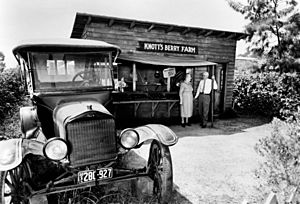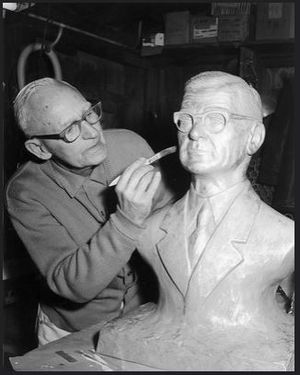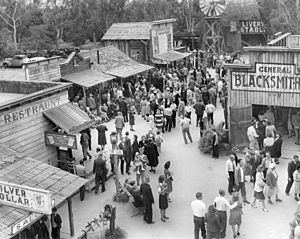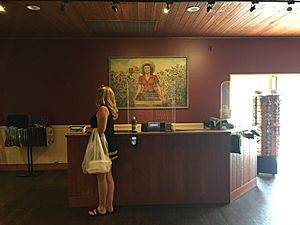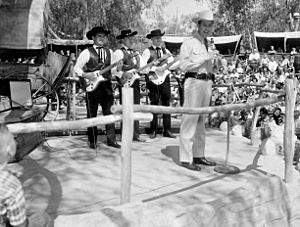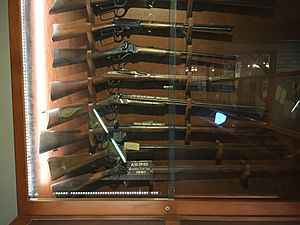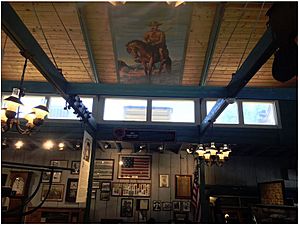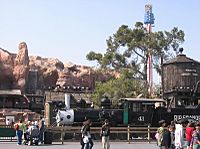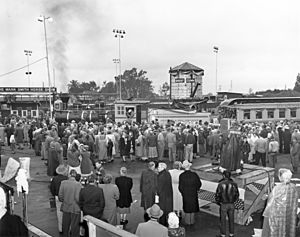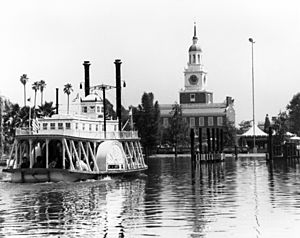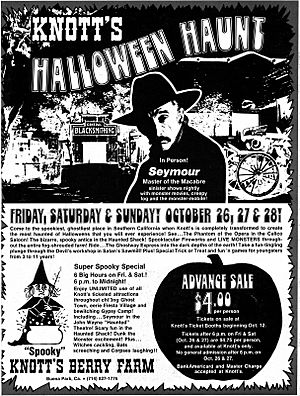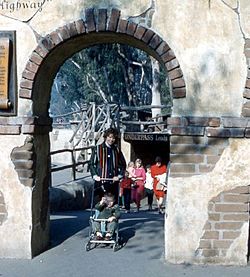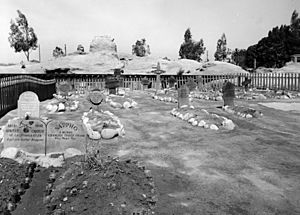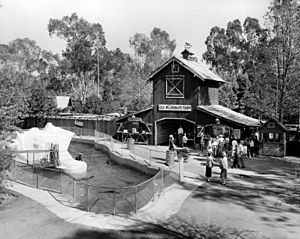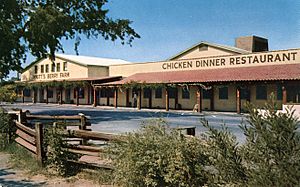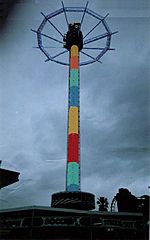History of Knott's Berry Farm facts for kids
The Knott's Berry Farm amusement park in Orange County, California, started as a berry farm. It was owned by Walter Knott (1889–1981). In the 1920s, Walter and his wife, Cordelia, sold berries, jams, and pies. They sold them from a small stand by the road near Buena Park.
In 1932, Walter Knott visited Rudolph Boysen's farm. There, he found a new type of berry. It was a mix of a blackberry, a red raspberry, and a loganberry. Boysen gave Walter his last six plants. Walter planted them, and his family sold the berries. People asked what they were, so he called them "boysenberries".
In 1934, Cordelia Knott (1890–1974) started serving fried chicken dinners. She used their own wedding dishes. For dessert, they served Walter's special Boysenberry Pie. Their restaurant was on Highway 39, a busy road. Many drivers stopped there on their long trips. The great location and good food made the restaurant very popular.
Contents
Fun Attractions Begin
As the restaurant grew, more shops and fun displays were added. These entertained guests waiting for a table. The Berry Market expanded. They added wishing wells, rock gardens, and water wheels. There was even a replica of George Washington's fireplace. Soon, the Knotts added gift shops and other attractions. These included a 15-million-year-old petrified log and a huge redwood slice. There was also a bee-hive and an oxcart for photos. The whole place was soon called Knott's Berry Place.
Volcano That Spits Steam
Walter built a 12-foot-tall volcano. He used lava rock from the Mojave Desert. It had a boiler inside that rumbled and hissed. It even spit steam when a button was pushed. Signs warned people to keep out. One sign said it was the "Only active volcano in Southern California."
Walter Knott said the volcano helped with long lines. When the restaurant was full, guests would go play with the volcano. They got so interested that he added a speaker system to call them for their meals. The volcano cost $600. Walter said it paid for itself in the first month.
Digging for Gold
Near the volcano, guests could enter a mine shaft. They followed a gold vein into a large pit. Here, they could "Pan-for-Gold." Visitors bought a ticket to pan for real gold and take it home. A prospector's mule would grind gold-bearing quartz nearby. This helped release the gold.
Artist's Studio Fun
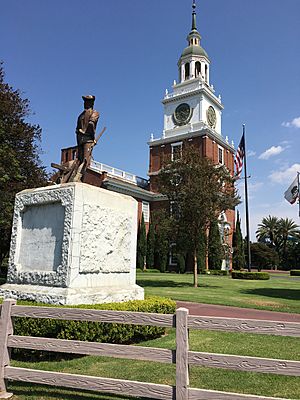
Artists have worked at Knott's for a long time. Claude Bell was a sculptor and artist there from 1947 to 1986. He made the famous concrete figures sitting on benches. These figures were modeled after real people. Bell ran the Artist Studio from 1951 to 1986. Today, artists still draw portraits of guests in about 20 minutes.
Ghost Town Adventures
Ghost Town is the oldest part of Knott's Berry Farm. Walter Knott built it to honor pioneers. His own grandparents came west in a wagon train. Ghost Town has most of the buildings he moved or built in the 1940s and 1950s. Many buildings on Main Street were finished in 1940 or 1941.
Paul von Klieben, the Artist
In 1939, Walter Knott hired an artist for a mural. But the artist quit. Knott then hired Paul von Klieben, a famous portrait artist. Von Klieben quickly finished the mural.
Knott then asked him to work on Ghost Town. Von Klieben planned most of Ghost Town. He drew concept art and floor plans. He also made new wood look old. Von Klieben painted many pictures. Some still hang in Knott's Berry Farm. He even painted concrete to look like rock. When Walter Knott bought the old town of Calico, California in 1951, von Klieben restored it.
Gold Trails Hotel
Walter started building a ghost town in 1940. He used buildings from real old west towns. The Gold Trails Hotel was the first. It honored the hard lives of early settlers.
Inside, a "Covered Wagon Show" was a 20 by 50-foot mural. It showed a wagon train crossing the desert. There were also 3D displays. A three-minute audio told the story of the 1849 pioneers. Special lights changed the scene from day to night.
Along Main Street, Walter filled "shops" with old items. "Deadwood Dick's" grave marker was there. The Assayer's Office had a funny scene. Hop Wing Lee, the Chinese Laundry owner, ironed and sang. The Barber shaved "One Eye Ike." A piano player played outside the Silver Dollar Saloon. The Sheriff's Office had a crooked poker game. Gold Dust Goldie's Hotel surprised guests with personal comments.
Pitchur Gallery
The "Pitchur Gallery" was spelled funny on purpose. In 1940, Gus Thornrose set up shop. He had standees and a Western saloon bar scene. There was even a stuffed bucking bronco. People could dress up in costumes. They could put their faces through holes in funny standees. Then, they took pictures with old cameras.
Blacksmith Shop
On Main Street, there were benches with concrete figures. These were of prospectors and dancing girls. A popular hand pump recirculated water for a horse trough. Old Betsy, a small steam train, was a photo spot. A real blacksmith worked in the shop. He heated iron and shaped souvenir horseshoes. This is still a working blacksmith shop. They make ironwork for the park. Guests can even order custom items.
General Store
The General Merchandise Store opened in 1944. Paul von Klieben designed it. It looked like stores from the Gold Rush days. It was filled with old-time goods.
Bottle House and Music Hall
The Bottle House (1944 or 1945) was made from empty liquor bottles. Building materials were hard to find back then. The Music Hall (1945) had a painting of a Native American family. It also had old musical instruments and music boxes. The mechanical birds in Swiss birdcages inspired Walt Disney to create Audio-Animatronics.
School House
The School House is a real one-room school house from 1879. Walter Knott bought it at an auction in Kansas. He wanted to preserve it as a museum. He had it taken apart, moved to California, and rebuilt.
Covered Wagon Camp
Another Western attraction was built. It was a pit with concrete rockwork. Country and Western bands played live music. Guests sat around a campfire. They were surrounded by Conestoga wagons. These wagons had funny slogans like "California, or bust." A food stand called Sutters sold burgers and hot dogs. Guests could eat their meals anywhere in the camp. Knott's Berry Farm became a popular place to visit.
Butterfield Stagecoach Ride
The Butterfield Stagecoach Line started in 1949. Four-horse teams pulled real historic coaches. Guests rode the stagecoach north to Whiskey Flat. They went through "badlands" with "bad men."
Western Trails Museum

In 1956, Knott's added the Western Trails Museum. Marion Speer had collected many items. These included rocks, Native American artifacts, and Old West relics. In 1956, Speer donated his 30,000 items to Knott's Berry Farm. He stayed on as the museum's curator. The museum is now south of the saloon in Ghost Town.
Calico Square Fun
In 1951, Walter Knott bought the old silver mining town of Calico. He restored the Calico Hotel there. Many buildings were rebuilt or moved to create Calico Square.
Calico Saloon Shows
The Calico Saloon was a main building in Calico Square. It had a stage for variety shows. A piano player, vaudeville acts, and dancing girls performed. The dancing girls did the Can-Can finale. Outside, shows included "Doctor I. Will Skinem" selling "Boysenberry Elixir." Cowboys faced the Sheriff in shootouts. Steve Martin even played banjo there when he was young. Today, stunt shows are at the Covered Wagon Camp.
Ghost Town & Calico Railroad Ride
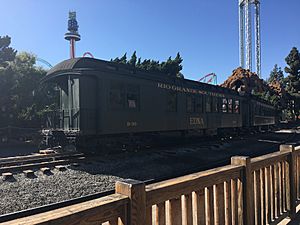
In 1951, work began on a rail route. They bought real narrow gauge steam engines from Colorado. These engines pulled vintage wooden passenger coaches. The ride opened on January 12, 1952. A highlight for many guests was meeting "train robbers" on the ride.
Calico Mine Train Adventure
Bud Hurlbut created the Calico Mine Train. It opened in 1960. Guests rode in ore cars on a narrated tour of the "Calico Mine." The ride had an underground lake and a steam geyser. A glowing cavern had stalactites and stalagmites. The train then became a "runaway" through a blasting zone. This made for a thrilling end.
Bud Hurlbut also ran other attractions at Knott's. He built the merry-go-round and boat rentals. He also built the Cordelia K. Steamboat. He continued to create world-class rides. These included the Antique Auto Ride and Timber Mountain Log Ride. The Calico Mine Train is still very popular.
Judge Roy Bean's Saloon
A copy of "The Jersey Lilly" Judge Roy Bean's Saloon opened in 1947. It had barrels on the bar with Boysenberry Drink fountains. Old gambling machines were changed to amusement games. They gave out souvenir tokens. Couples could even "Get Hitched" in a funny mock wedding.
East Side Fun
A tunnel was built under Beach Boulevard. This allowed development on the east side. This area included Jungle Island, Knott's Lagoon, and later, Independence Hall.
Knott's Lagoon
North of Jungle Island, Knott's Lagoon was an artificial lake. A miniature railroad circled it. The lake had rental rowboats and paddle-boats. The Cordelia K. was a side-wheel riverboat named for Walter's wife. People could buy corn to feed the ducks. Knott's Lagoon was later paved over for the main parking lot.
More Park Expansion
Knott's Berry Farm grew in the 1950s. They added new displays and attractions. Disneyland was built nearby, but the parks were different. Walt Disney and Walter Knott had a friendly relationship.
Haunted Shack Mystery
The Haunted Shack opened in 1954. It showed strange things that seemed to defy gravity. A tour guide would show how people appeared to change size. Water seemed to flow uphill. A broom stood unsupported at a slant. The shack was removed in 2000.
El Camino Real – The Kings Highway
In 1956, a miniature El Camino Real was finished. It ran north through the park. Along the way were 21 small adobe buildings. Each showed a miniature model of a California mission.
Bird Cage Theatre Shows
Knott's Bird Cage Theatre had live melodramas. These were old-time plays with funny names. The audience cheered for the hero and booed the villain. Many actors started their careers here, including Steve Martin. Between shows, actors would pose for photos.
Boot Hill Cemetery
In Boot Hill Cemetery, headstones had funny sayings. They told macabre jokes about how people died. Hiram McTavish's grave even invited people to feel his "heartbeat."
Old MacDonald's Farm
Old MacDonald's Farm was a petting zoo. It had goats, bunnies, and chickens. There were even two hundred-year-old Galapagos tortoises. For a short time, there was a baby elephant. Guests could buy food to feed the animals. Henrietta, a piano-playing chicken, would peck out a song for a nickel. The petting zoo also had a unique carousel swing. A mule walked in a circle to power the swings.
Independence Hall Replica
In 1966, a replica of Independence Hall was built. It was copied brick-for-brick. Visitors can enter for free. It has an audio presentation about the United States Declaration of Independence. It also has a replica of the Liberty Bell. This replica was so accurate that it was used in the movie National Treasure. Its blueprints were even used to help restore the original Independence Hall in Philadelphia.
Park Becomes Enclosed
In 1968, Knott's Berry Farm started charging admission for the first time. The family put a tall fence around the park. This enclosed three themed areas:
- Calico Ghost Town, as it was originally built.
- Fiesta Village, showing Spanish California.
- Gypsy Camp, a new area with games and a large theater.
After the fence, the park grew quickly.
Timber Mountain Log Ride
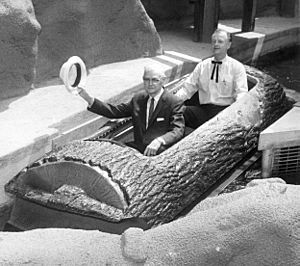
Bud Hurlbut opened the Log Flume in 1969. It was first called the Calico Log Ride. The first public riders were John Wayne and his son. Many call it one of the best log rides in the world. It has old logging equipment and forest scenes. There is a dark drop inside.
1970s and Beyond
On April 12, 1974, Cordelia Knott passed away. Walter then focused on political causes.
The Gypsy Camp area was re-themed to the Roaring Twenties. It added bumper cars and Knott's Bear-y Tales. A 1920s-era airfield area was added. It had a dance hall, Sky Cabin, and the Motorcycle Chase roller coaster. The new roller coaster Corkscrew was a key addition.
The Sky Tower was built to hold two attractions. The Parachute Sky Jump (now closed) and the Sky Cabin. The Sky Cabin slowly rises and spins. It offers great views of the park. It closes during strong winds or rain.
Corkscrew opened in 1975. It was the first modern roller coaster to go upside down twice. It was designed by Arrow Dynamics.
On December 3, 1981, Walter Knott died. His children continued to run Knott's as a family business for 14 more years.
Wild Water Wilderness
In the 1980s, Knott's added new themed areas and big rides:
- Kingdom of the Dinosaurs (1987)
- Bigfoot Rapids (1988), a whitewater river rapids ride. This was the main ride in the new Wild Water Wilderness area.
The Boomerang roller coaster replaced the Corkscrew in 1990. It goes through a cobra roll and a vertical loop. This gives riders six inversions each trip.
Mystery Lodge (1994) was a live show. It used special effects to tell a story. It was inspired by a popular exhibit at Expo 86. The show recreates a summer night in a village. Guests listen to a storyteller. They learn about the importance of family.
|


